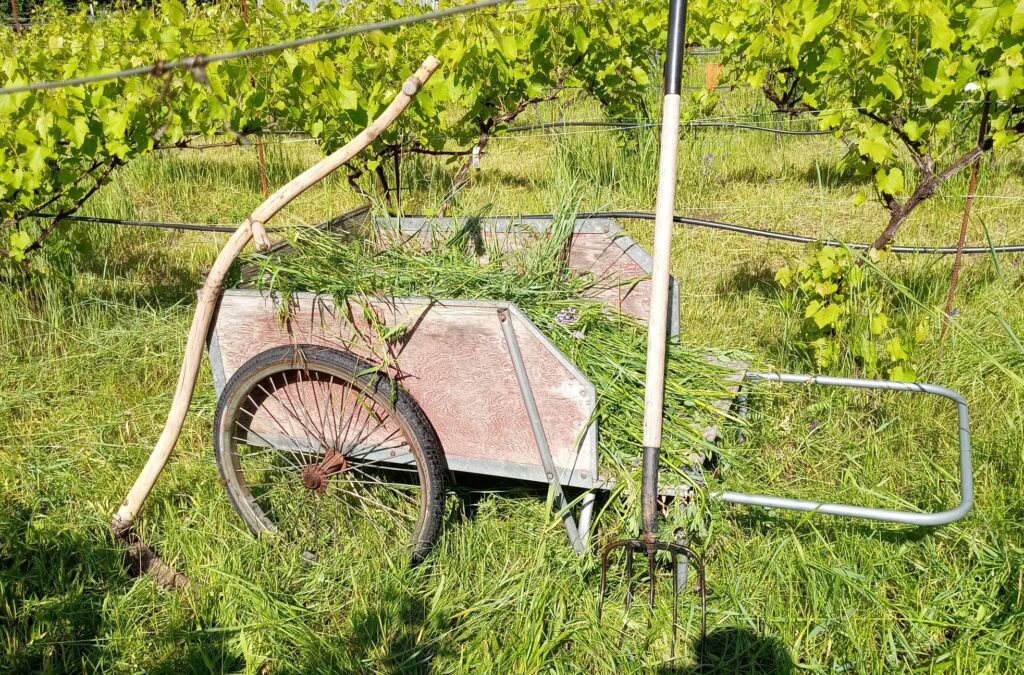The Grass is Greener
With this very wet Spring everything looks especially green. The green color is from chlorophyll, the molecule critical to photosynthesis, which turns sunlight into plant energy, specifically sugars. Looking at the chest-high grass and purple vetch which has taken over the aisles between my rows of grape vines, I had to envy those farmers who could make great use of this abundance by running cattle or sheep on it. I needed to cut it before it completely took over the vineyard so I could get in to do thinning and other operations on the grape plants. That green colored chlorophyll is rich in nitrogen, the fertilizer most often added to commercial fields. Nitrogen turns a field’s color to a darker green. It does not necessarily mean that the crop is more nutritious. But to me this naturally rich green indicates high food value.
Not one to let that much nutrition go unused, I began thinking about its potential. I remembered a neighbor we had when I was young. He threw grass clippings over the bank behind his house and added a lot of coffee grounds to them. That seemed strange to me at the time and I asked his kids about it. They told me that their dad was an avid fisherman and that the grass clippings and coffee propagated earth worms, probably night crawlers that he used as bait.

I have been building compost piles in old apple bins with the bottoms removed. Before I started using the bins, wild turkeys would tear apart my compost piles looking for worms, seeds or whatever bugs they could eat. This was a big mess that I tried to prevent by covering the pile with wire mesh fencing. Having the big compost pile served two purposes. I wanted the compost and I wanted to have a place that worms could live during the winter without freezing.
It worked. Now that there is plenty of warmth and water, the compost bins have taken on new life. Mushrooms sprout from the top. Worms show up underneath. Deer browse on squash growing over the sides. Deep inside the temperature is 120° F. That is too hot for worms. But they move to the sides and around the hot spots. A worm’s digestive track is like a chicken’s gizzard. Both need grit to grind up food. Worms also really like mushy food. So a combination of food that will rot, dirt that has grit and sawdust or straw that has cellulose which is easy to crawl through works well for them.
Looking at the green grass and thinking about how it can enrich the soil I face a number of tradeoffs. Contrary to intuition, grass really gets healthier if it is eaten or cut. Grass has a huge root system compared to most plants. In the “wild” it gets eaten, digested and turned into manure and urine, essential fertilizers. Animals trample it, working those fertilizers into the soil and providing bare ground for new seeds. That way clover and other forbs can grow providing food for bees above ground and nitrogen fixation underground. The grass springs back from its huge root system. The prairie lives on and the grass really is greener.
But that system depends on animals rotating in briefly to make it all work. If I cut it, I need to take it away or leave it in place. If I take it to a compost pile, it can rot and feed the worms. But then I need to move the compost plus worms back to the vineyard which is a lot of work. Left on the ground, the nutrients could leach out, dry out or just degrade in the sunlight, I needed some advice. Since these were questions that people who make hay face all the time, I talked to friends with livestock about the nutrition in hay.
You would think that the nutrition in hay is just “cut and dried”, so to speak. It’s not. There are early grasses and late ones, alfalfa can be good for cows and bad for horses. There are early grasses and late ones. You might prefer the seed heads almost formed for more protein or green leaves and flowers, dry and still green. Even just looking at hay doesn’t tell you everything. The same crop cut late in the day will have more carbohydrates than when cut in the morning. But with a short window to get it dried in the field, you might want to cut early. Then there is silage, which adds nutrition during fermentation but needs expensive equipment. So much for “cut and dried”.
There is a history of using animals in vineyards. Sheep, goats, geese and cows have all worked to some extent. One viticulturist, Kelly Mulville, found that by raising his trellis out of the reach of sheep and running them through the vineyard when the grass was up, he could eliminate the tractor labor mowing grass and the hand labor of removing suckers from the vines. At the same time the biodiversity in his vineyard multiplied many fold and production was as good as or better than ever. The same is no doubt true in orchards.
Short of reworking my vineyard for sheep, falling back on doing my own testing and experimentation, seems like the best practice moving forward. Sap testing shows that the grass is fairly sweet right now and the vetch is nearly as sweet though definitely juicier. I will compost some of both and leave the mulch in some rows. Time will tell which works out the best and where the grass really is greener.
